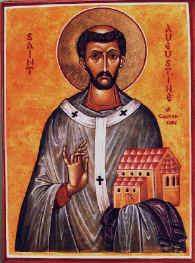Augustine of Canterbury,
Bishop and Missionary
28 May 605
 The Christian Church
was established in the British Isles well before 300. Some scholars believe that it
was introduced by missionaries from the Eastern or Greek-speaking half of
the Mediterranean world. Celtic Christianity had its own distinctive culture, and
Greek scholarship flourished in Ireland for several centuries after it had died
elsewhere in Western Europe.
The Christian Church
was established in the British Isles well before 300. Some scholars believe that it
was introduced by missionaries from the Eastern or Greek-speaking half of
the Mediterranean world. Celtic Christianity had its own distinctive culture, and
Greek scholarship flourished in Ireland for several centuries after it had died
elsewhere in Western Europe.
However, in the fifth century Britain was invaded by non-Christian Germanic tribes: the Angles, Saxons, and Jutes. They conquered the native Celtic Christians (despite resistance by, among others, a leader whose story has come down to us, doubtless with some exaggeration, as that of King Arthur), or drove them north and west into Cornwall, Wales, Scotland, and Ireland. From these regions Celtic Christian missionaries returned to England to preach the Gospel to the heathen invaders.
At the end of the sixth century anyone would have said that Augustine had found his niche in life. Looking at this respected prior of a monastery, almost anyone would have predicted he would spend his last days there, instructing, governing, and settling even further into this sedentary life.
But Pope Gregory the Great had lived under Augustine's rule in that same monastery. When he decided it was time to send missionaries to Anglo-Saxon England, he didn't choose those with restless natures or the young looking for new worlds to conquer. He chose Augustine and thirty monks to make the unexpected, and dangerous, trip to England. They arrived in Kent in 597, and the king, whose wife was a Christian, allowed them to settle and preach. Their preaching was outstandingly successful, the people were hungry for the Good News of salvation, and they made thousands of converts in a short time. In 601 the king himself was converted and baptised. Augustine was consecrated bishop and established his headquarters at Canterbury. From his day to the present, there has been an unbroken succession of archbishops of Canterbury.
In 603, he held a conference with the leaders of the already existing Christian congregations in Britain, but failed to reach an accommodation with them, largely due to his own tactlessness, and his insistence (contrary, it may be noted, to Gregory's explicit advice) on imposing Roman customs on a church long accustomed to its own traditions of worship. It is said that the English bishops, before going to meet Augustine, consulted a hermit with a reputation for wisdom and holiness, asking him, "Shall we accept this man as our leader, or not?" The hermit replied, "If, at your meeting, he rises to greet you, then accept him, but if he remains seated, then he is arrogant and unfit to lead, and you ought to reject him." Augustine, alas, remained seated. It took another sixty years before the breach was healed.
Augustine was only in England for eight years before he died in 605. His feast day is celebrated on May 26 in England and May 28 elsewhere.
Acknowledgements:
Text adapted from James Kiefer's Christian Biographies
Icon from Saint
Hilarion Monastery